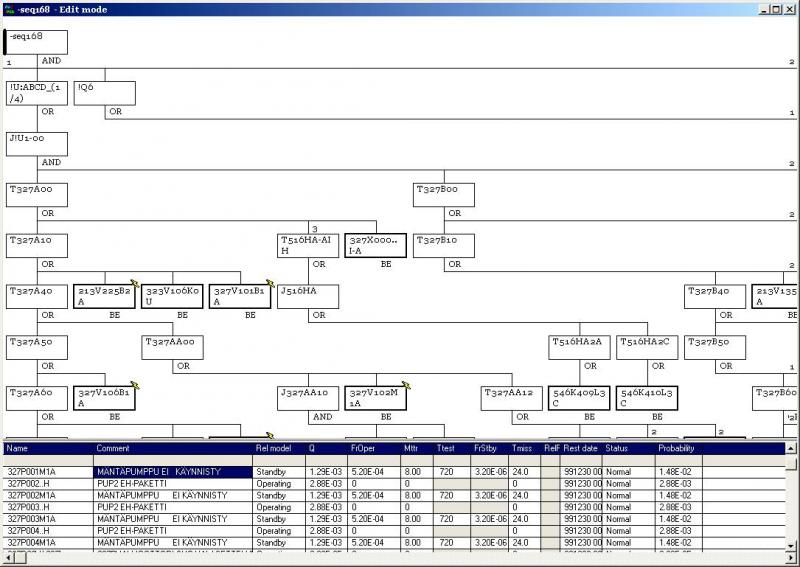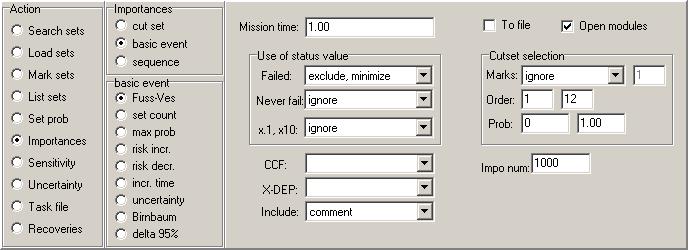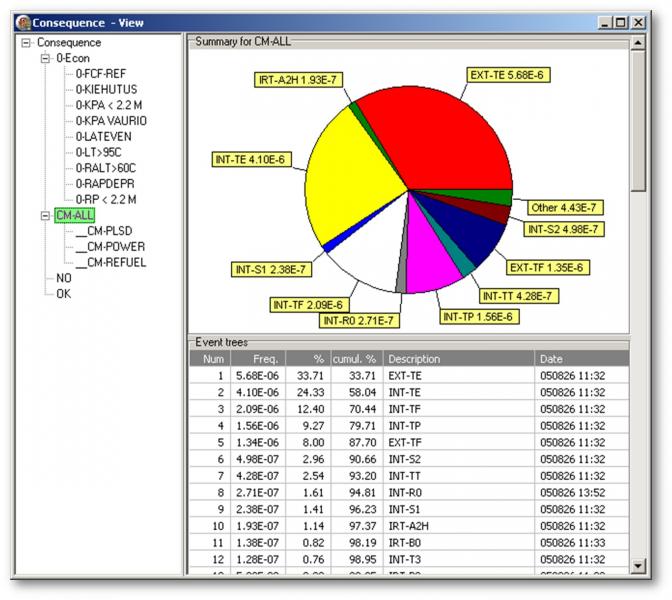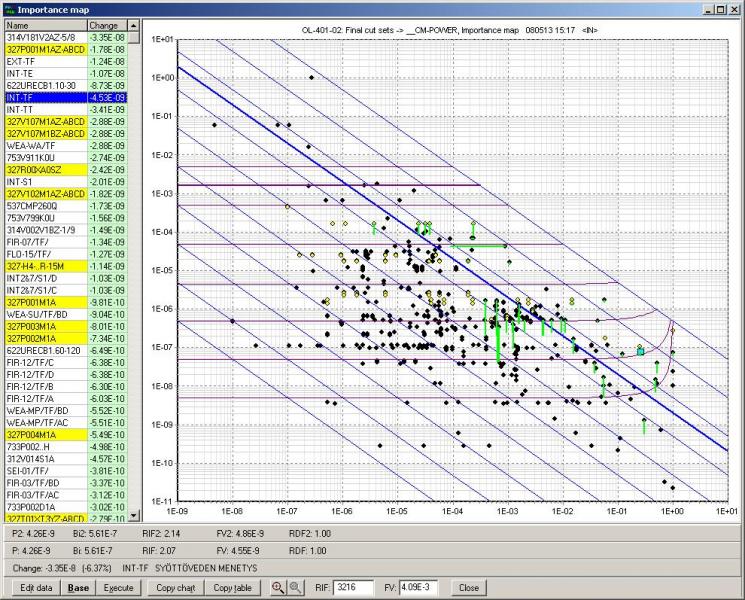Download FinPSA Training, version 2.1
FinPSA - Tool for professional living PSA
 FinPSA is a comprehensive risk and reliability analysis tool intended for full scope PSA/PRA modeling. The development of the tool started in 1988 and it is now maintained by VTT. FinPSA is designed to support the main activities related to PSA/PRA by easy model creation, efficient and versatile analysis, good traceability, flexible reporting and information exchange capabilities. All these features make your work comfortable in living PSA, plant assessment and operational modifications.
FinPSA is a comprehensive risk and reliability analysis tool intended for full scope PSA/PRA modeling. The development of the tool started in 1988 and it is now maintained by VTT. FinPSA is designed to support the main activities related to PSA/PRA by easy model creation, efficient and versatile analysis, good traceability, flexible reporting and information exchange capabilities. All these features make your work comfortable in living PSA, plant assessment and operational modifications.
Modelling features
Teamwork
 FinPSA is developed for teamwork. PSA models can be shared or private models. Shared models reside in a server, and can be accessed and edited simultaneously by several users. A locking mechanism prevents two users from editing the same part of the PSA model at the same time. PSA models can be copied between shared and private (user’s own PC) locations.
FinPSA is developed for teamwork. PSA models can be shared or private models. Shared models reside in a server, and can be accessed and edited simultaneously by several users. A locking mechanism prevents two users from editing the same part of the PSA model at the same time. PSA models can be copied between shared and private (user’s own PC) locations.
Co-operation with other programs
FinPSA works together with common Windows programmes for importing and exporting data base tables, fault trees, events trees, and almost every item in the model. Results are available in several formats for Windows clipboard. These features support the creation of models, analysis and reporting of risk information.
Hazard tables
FinPSA hazard table lists external events and their dependences and maps them automatically to fault trees during cut set search. Conditional failure probabilities with uncertainty can be defined for each dependence. There is no need to modify system fault trees or use house events.
 Asymmetric CCF models
Asymmetric CCF models
FinPSA allows new flexibility in modeling partial diversity. For example, subgroups of similar batteries, whose lifetimes differ significantly, can be treated as asymmetrical CCF.
Task-oriented model for control systems
Complex I&C system models can be isolated from the system fault trees by a clear interface. Fault trees can refer to control tasks and control tasks can be linked to fault trees, e.g. for support functions like electric power or cooling. The I&C modelling language is based on communication vector representation, which is suitable for the modeling of distributed control systems. The modelling is compact and allows convenient expression of large systems.
Model solving and analysis
 Efficient and versatile cut set handler
Efficient and versatile cut set handler
Calculations with already searched minimal cut sets are quick and versatile. They can be performed for one cut set file, or automatically for all accident sequences in one event tree or the whole PSA model. Results are always up-to-date. FinPSA automatically detects the modified parts of model and performs related update calculations.
Multithreading and parallel computation
FinPSA uses multithreading to fully utilize multicore processors and ubiquity of network connections. When minimal cut set search for a PSA projects is started, each core performs its own cut set search. Shared PSA projects can be solved by several multi-core computers in a network.
Dynamic computation environment for PSA team
While resolving a shared project, users can control how their computers are used in the parallel computation. A new computer can be added in the computation on the fly with a single click. The user can also leave the parallel computation at any time and the remaining resources complete the task.
If the user is not active, he may define his workstation as a computation resource in the network. Idle resources are automatically utilized in a parallel computation.
Calculations are fail-safe: an interrupted calculation can be resumed later. The already calculated parts are available for analysis even before restart.
History file is continuously updated during the calculation and is visible for the whole PSA team.
 Hierarchical results
Hierarchical results
FinPSA searches for cut sets for each event tree sequence. After the search, the cut sets of individual sequences are automatically combined and grouped according to user-defined hierarchy of consequences. On the top level, FinPSA produces cut set files classified by consequence only. Any number of intermediate levels can be defined.
New level of traceability
Each minimal cut set can be traced back to the event tree and accident sequence, and visualized in the automatically generated sequence fault tree — with one mouse click.
 Importance map
Importance map
For risk-informed applications FinPSA has interactive importance map. It displays basic event probability, safety margin, F-V and RIF importances for all or selected basic events.
Level 1+ analysis
Interface trees
For level 1 and level 2 analysis tool integration FinPSA uses interface trees. Interface trees link event tree sequences to plant damage states. Each cut set resulting from interface tree computation can be traced back to the event tree accident sequence and interface tree accident sequence, and visualized in two automatically generated sequence fault trees. One fault tree shows the event tree part and the other the interface tree part.
Level 2 analysis
Level 2 computation is based on the containment event tree (CET) modelling methodology. The CET model consists of a graphical event tree which represents the progression of an accident sequence and associated models that are described by a specialised CET programming language (CETL). Statistical analyses are performed automatically after each simulation. A risk integrator is used to combine the results of individual CET’s to total PRA results.
Materials
- FinPSA Training, version 2.1 (Training version is available from the OECD NEA data bank)
- FinPSA leaflet
- PRA offering
- Research services
FinPSA public references
- STUK - Radiation and Nuclear Safety Authority, Finland
- Swiss Federal Nuclear Safety Inspectorate ENSI, Switzerland
- Teollisuuden Voima Oyj, Finland
- AREVA NP GmbH, Germany
- Risk Pilot AB, Finland
- Westinghouse Electric Company LLC, USA
- Toshiba Corporation, Japan
- VTT Technical Research Centre of Finland Ltd., Finland
References
-
Björkman, K.; Tyrväinen, T.; Niemelä, I.; Mätäsniemi, T. 2013. Developing PRA computer code requirements based on probabilistic risk analysis practices. Proceedings. American Nuclear Society, pp. 1215 - 1226. International Topical Meeting on Probabilistic Safety Assessment and Analysis, PSA 2013, 22 - 26 September 2013, Columbia, South Carolina, USA
